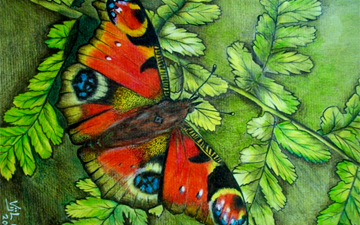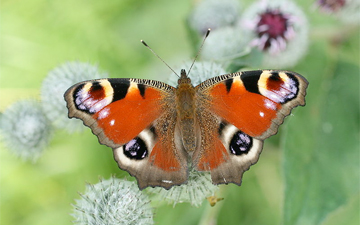The European Peacock (Inachis io), more commonly known simply as the Peacock butterfly, is a colourful butterfly, found in Europe, temperate Asia as far east as Japan. It is the only member of the genus Inachis (the name is derived from Greek mythology, meaning Io, [the daughter] of Inachus). It should not be confused or classified with the “American peacocks” in the genus Anartia; these are not close relatives of the present species. The Peacock butterfly is resident in much of its range, often wintering in buildings or trees. It therefore often appears quite early in spring. See also Anglewing butterflies.
The butterfly has a wingspan of 50 to 55 mm. The base-colour of the wings is a rusty red, and at each wingtip it bears a distinctive, black, blue and yellow eye-spot.
The caterpillars grow up to 42 mm in length.
(From Wikipedia, May 26th, 2010)
– – –
Usually one generation is produced each year. Females lay eggs in groups underneath nettle leaves during May, after around two weeks the eggs hatch. The caterpillars live in groups, protected by a web of silk, before dispersing to pupate, hanging underneath vegetation (3). The adults emerge around two weeks later, in late July. They gather together at sources of nectar, building up reserves to see them through hibernation, which usually begins in September (2) and occurs in hollow trees and other refuges, including attics (4). They do not mate until the following year, emerging from hibernation as early as February, with peak emergence occurring in April. Males defend territories in sunny locations, and chase any females that pass by (2).
(From EOL via ARKive)
– – –





